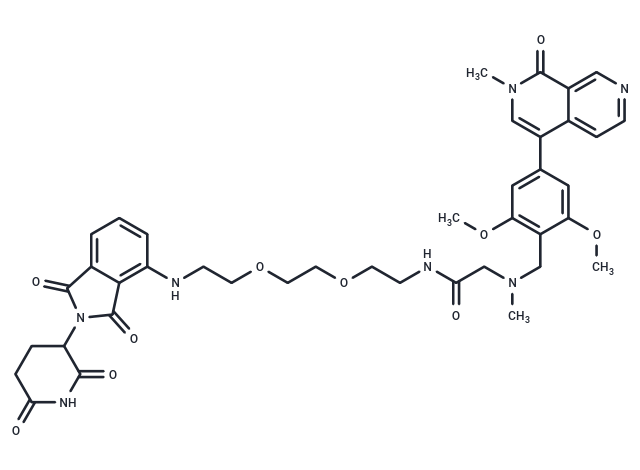Shopping Cart
- Remove All
 Your shopping cart is currently empty
Your shopping cart is currently empty

dBRD9 is a PROTAC. dBRD9 is a double-acting molecule, partially containing Bromodomain-containing protein 9 (BRD9), ligand that recruits the cereblon E3 ubiquitin ligase. Ligand that recruits the cereblon E3 ubiquitin ligase. dBRD9 can inhibit the degradation of BRD9 in MOLM-13 cells, and the IC50 is 104 nM.

| Pack Size | Price | Availability | Quantity |
|---|---|---|---|
| 1 mg | $131 | In Stock | |
| 5 mg | $328 | In Stock | |
| 10 mg | $528 | In Stock | |
| 25 mg | $920 | In Stock | |
| 50 mg | $1,390 | In Stock | |
| 100 mg | $1,930 | In Stock | |
| 1 mL x 10 mM (in DMSO) | $457 | In Stock |
| Description | dBRD9 is a PROTAC. dBRD9 is a double-acting molecule, partially containing Bromodomain-containing protein 9 (BRD9), ligand that recruits the cereblon E3 ubiquitin ligase. Ligand that recruits the cereblon E3 ubiquitin ligase. dBRD9 can inhibit the degradation of BRD9 in MOLM-13 cells, and the IC50 is 104 nM. |
| Targets&IC50 | BRD9 (MOLM-13 cells):104 nM |
| In vitro | dBRD9 has prompt rapid BRD9 degradation over a broad range of concentrations. The degraded BRD9 showed significantly enhanced efficacy(10-to-100-fold). These findings reveal the tractability of non-BET bromodomain-containing proteins to chemical degradation and highlight lead compound dBRD9 as a tool for the study of BRD9[1]. |
| In vivo | The final concentration of dBRD9 of 0.3 nM was mixed in silk fibroin hydrogel and injected into mice. It was found that BRD9 degradant alleviated ZOL-related ONJ. The ONJ-dBRD9 group is filled with well-organized newly formed trabecular bone, with 80% reduced incidence rate of osteonecrosis and periosteal reaction compared with the ONJ-control group[1]. |
| Alias | dBRD-9, dBRD 9 |
| Molecular Weight | 783.83 |
| Formula | C40H45N7O10 |
| Cas No. | 2170679-45-3 |
| Smiles | O=C1C=2C(C(=O)N1C3C(=O)NC(=O)CC3)=CC=CC2NCCOCCOCCNC(CN(CC4=C(OC)C=C(C=C4OC)C=5C=6C(C(=O)N(C)C5)=CN=CC6)C)=O |
| Relative Density. | 1.357 g/cm3 (Predicted) |
| Storage | Powder: -20°C for 3 years | In solvent: -80°C for 1 year | Shipping with blue ice. | |||||||||||||||||||||||||||||||||||
| Solubility Information | DMSO: 90.0 mg/mL (114.8 mM), Sonication is recommended. | |||||||||||||||||||||||||||||||||||
Solution Preparation Table | ||||||||||||||||||||||||||||||||||||
DMSO
| ||||||||||||||||||||||||||||||||||||

Copyright © 2015-2025 TargetMol Chemicals Inc. All Rights Reserved.